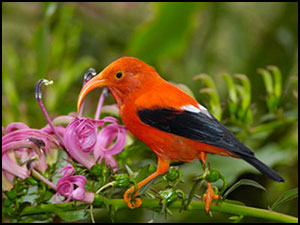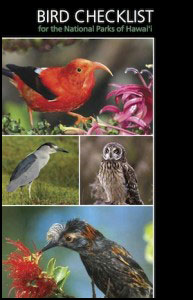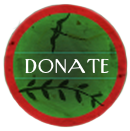KOKEʻE FLORA & FAUNA
BIRDS

In the Museum ~ Birds native and introduced to Kauai are featured in several exhibits and many photographs. You can learn where different introduced birds came from, and appreciate difference between the introduced Barn Owl and our native Hawaiian owl, the Pueo — the pueo is smaller and browner, and flies in the daytime, not the night.
Resources for bird watchers include several excellent birding books and an audio CD of Kaua`i forest bird sounds. A “Bird Checklist for the National Parks of Hawai`i” is available for free download from the Hawai`i Pacific Parks Association. The booklet is a great companion to Audubon’s “Hawaii’s Birds,” which provides photos and info about both native and non-native birds. bird booklet

Hear the calls of `Apapane, I`iwi, `Akeke`e, `Amakihi, `Anianiau, `Akikiki, `Elepaio, and Puaiohi. Visit Sounds Hawaiian - Birds of Hawai‘i and Other Natural Sounds
Free Ringtones! Putting the unique twitters, calls, and warbles of Hawaiian birds on your phone is a great way to spread the word about native species and to remind others why these “jewels of the forest” need our protection. Hui o Laka trustee David Kuhn of SoundsHawaiian donated bird call ringtones to the Center for Biological Diversity that you can download free. Visit www.rareearthtones.org/ringtones/index.html and click on the ‘Download’ menu > sign in > then look for the section “New! Hawaiian Species”.
CHICKENS:
Conservation message from Hui o Laka:
Why we recommend you don’t feed the chickens!
It’s become a tradition over the last 50 years for kids to feed the chickens at park lookouts and around the Lodge at Kokee and Koke’e Museum. Here’s why we recommend you help change that. We’ve created “an unnatural population” of chickens by feeding them. Such a huge flock of chickens creates these problems:
- It’s not sanitary or pleasant to walk through kukae moa (chicken manure!).
- Lots of chickens in the park can make for unsafe driving when visitors try to avoid them or brake for them. In actuality, these parking-lot saavy birds seldom get squished by cars. That happens to Nene (sadly).
- Chickens are very bad for native Hawaiian plants – they compact earth in some places and dig it up in others. The Nature Trail would recover more quickly without so many chickens.
- Chickens are very bad for native Hawaiian birds – they carry avian pox and other diseases which kill native birds.
Will the chickens starve if we don’t feed them?
Nope, but for awhile the area may suffer increased scratching as chickens leave parking and public areas hungry. What eventually will happen is that they will disperse, as well as have lowered fertility rates (fewer eggs per clutch) once they’re weaned off high-protein cracked corn.
The History and Myth of Wild Chickens at Koke’e
Though most of us cannot imagine any Koke’e overlook or parking lots without lots of wild chicken, Tutut Sarah Kauaka, a long time Hui o Laka member who fondly remembers her family time in Koke’e, says there were no chickens in the area in the 1930’s.
Wild chickens were actively promoted in the 1950s as a wildlife visitor attraction. Forester and Hui o Laka co-founder, Joe souza, fed them in order to get a flock going, a tradition that has continued for many years with the sale of little bags of cracked corn at the Lodge at Koke’e.
The birds also came to be associated with an early Koke’e Museum director, Dr. Gladys Falsaw, who many remember as “the chicken lady.” She was very strict with little boys who hasseled or chased the chickens that gathered between the Lodge and Koke’e Museum.
Everyone noticed that Koke’es chicken population really exploded after Hurricane Iniki – some “blew in,” it seemed.
Koke’e’s chicken flocks are no longer the “jungle fowl” they once were – English scientists recently tested their blood and found there is hardly any genetic evidence of their origin as “jungle fowl” that the Hawaiians originally brought to the islands. This is probably the result of folks who have dropped off unwanted domestic fowl, from Rhode Island Reds to gangly white Leghorns, in Kokee.
COUNT THE NENE - DON'T FEED THEM!
NENE:
Perhaps the most obvious bird life in the parks are the wild chickens, though occasionally nene geese are sighted (Click here for a form to Count The Nene).
Between May and September, you’re likely to see Hawaii’s State Bird, the Nene goose while you’re in Koke’e State Park. During breeding season, from October through April, Nene are off in the bush and less social
If you see this lovely bird in the park, enjoy this lovely goose – but please restrain yourself from feeding them. A distant relative of the Canada goose, the Nene, like all geese, are easily domesticated.
If you feed the nene, they could get sick. If they become dependent on human hand-outs, they’ll never teach their fledglings how to forge in the wild, where they get a much healthier diet than human food or cracked corn. Instead of feeding chickens or nene (see why not below), help our State Wildlife Biologist count the Nene!
Here’s how: Help track their progress by reporting the color of their leg bands, and the letters on the bands.
Fill out this on-line form and we’ll get it to our State Wildlife Biologist.
FORM – Click Below To Download Form:
NENE SIGHTINGS IN WAIMEA CANYON & KOKE’E STATE PARK
More Activities to Come!
SEND YOUR IDEAS
Please email us or call us at (808) 335-9975 to let us know about Activities you would like to see at Kokee State Park.



